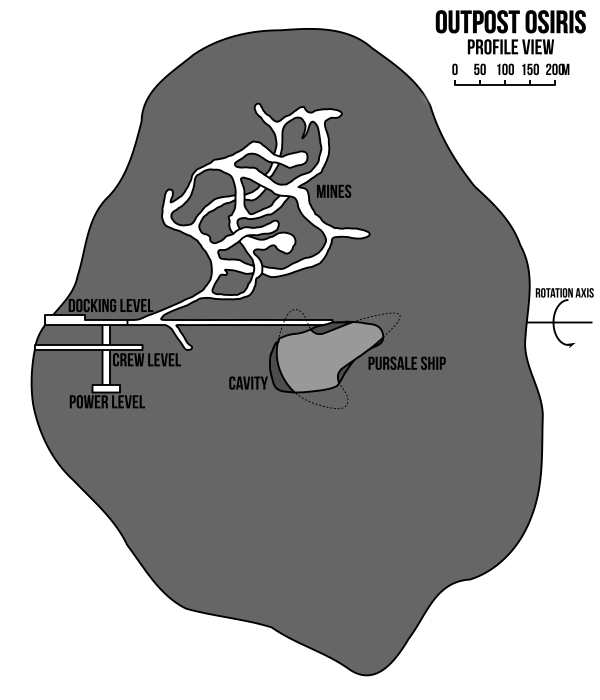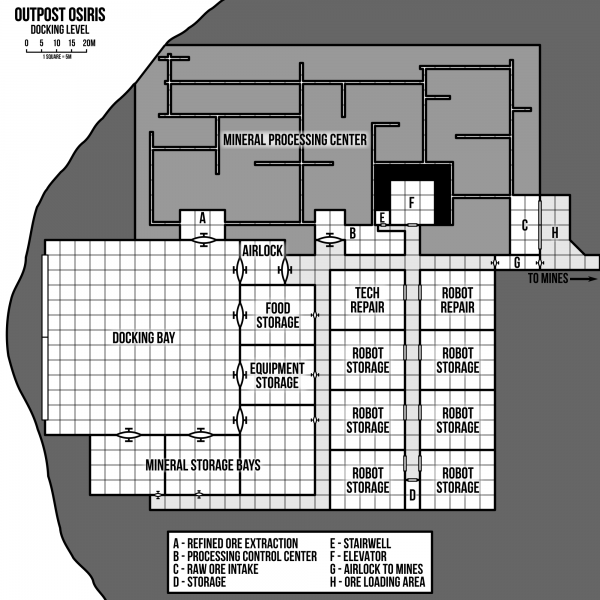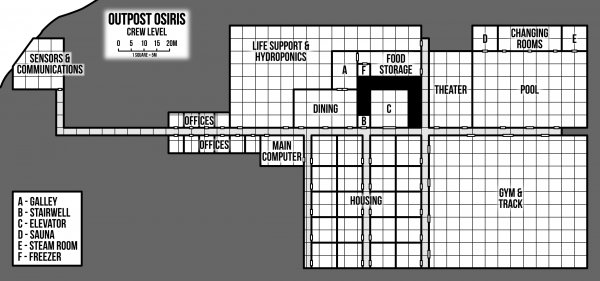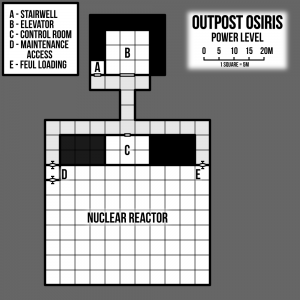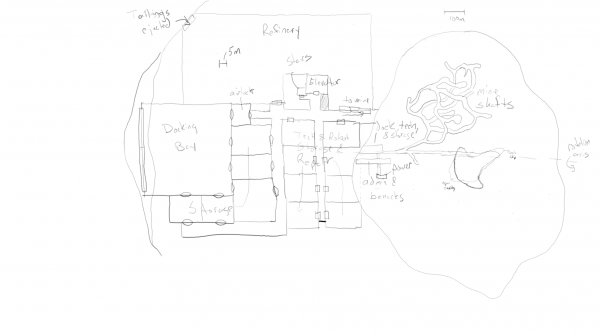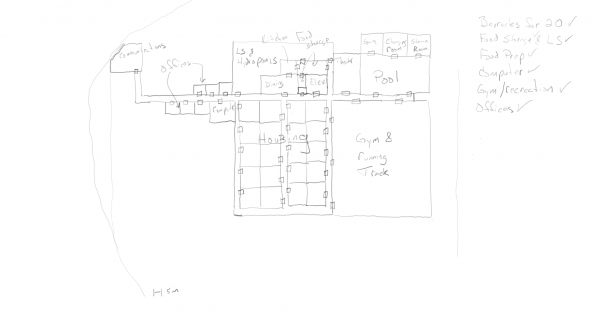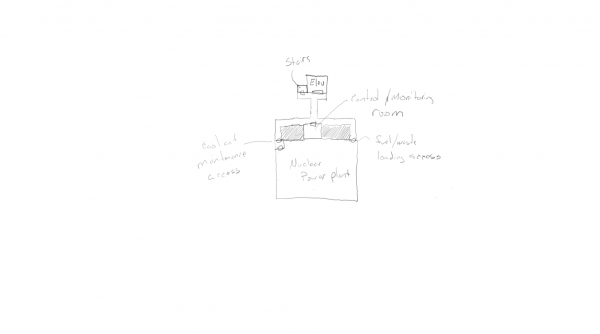I was going to post another ship next but realized that I should probably talk a little bit about the way I redesigned the engines in my new starship construction system. Otherwise, some of the bits of information about the ships won’t make sense. I’ve published some of this on-line before but I don’t remember exactly where so I’m repeating it here for completeness. Here is the section on engines from the starship construction system document.
Engines
Now that we know the mass of our ship, it’s finally time to
determine its propulsion. Each type and size of engine is rated to have a
specific thrust and fuel capacity. Your ship’s hull size determines the maximum
number of engines it can support. You don’t have to have to fill all your
engine slots if that number of engines is not needed to achieve the performance
you desire. And regardless of hull size
and engine type, the maximum acceleration of any ship is 6g.
|
Hull Size
|
Max Engines
|
|
1
|
1
|
|
2-4
|
2
|
|
5-8
|
4
|
|
9-12
|
6
|
|
12+
|
8
|
(Note: I didn’t even follow my own rules when I created the PGC C-10 Fast Courier as I gave it 4 engines at HS 4. This is something I’m still thinking about/working on.)
Engine thrust is given as an arbitrary thrust rating that has been scaled to work with the mass of the ship as given in tons. To determine the maximum acceleration of your ship, add up the thrust ratings of all your engines and divide that by the total mass of your ship in tons. The resulting number is the maximum acceleration of your ship in multiples of one standard gravity (10 m/s/s). Round all fractions down to the nearest tenth of a g.
Chemical Engines
These engines use a high efficiency chemical fuel that burns
and is expelled out the engine nozzle to provide thrust. These engines are relatively cheap and easy
to produce. While very powerful, because
of the large volume of fuel needed, these engines have limited capability in regards
to how long the engines can operate on a single fuel load. These engines are typically used for
ground-to-space shuttles and system ships.
Ion Engines
Ion engines work by ionizing hydrogen and accelerating the
resulting protons and electrons to high velocity and expelling them out the
back of the engine to provide thrust. Each
engine contains a small nuclear reactor to provide the power needed to ionize
the hydrogen and accelerate the particles to the relativistic speeds needed to
generate thrust. This reactor uses the
same atomic fuel pellet as an atomic engine but only needs to be replaced once
every 10 years. The initial fuel pellet
is included in the cost of the engine.
While not as powerful as chemical or atomic engines, Ion
engine fuel is relatively cheap and if a ship is properly equipped, can be
harvested from any gas giant for free.
Because of the nature of the engine, ships with ion engines
cannot land on or take off from planets.
Atomic Engines
An Atomic engine is a supercharged version of the chemical engine and uses the same fuel. The engine works by generating a quantum field that temporarily increases the momentum of particles by a factor of hundreds. These temporarily super-massive particles are ejected out of the back of the engine to generate thrust for the ship. Because each particle is effectively much more massive, less fuel is needed to achieve the same thrust and instead of a single fuel load lasting for only few minutes of thrust, it can last for days and allow the ship to accelerate to Void jump speeds.
However, generating this field requires a huge amount of
energy (which is transferred to the particles) during operation. To provide this power, each engine contains
its own nuclear reactor, similar in design to the reactor in the ion engine. However, the large power requirement of the
atomic engine means that it consumes one atomic fuel pellet after only 10,000
minutes of full thrust operations (about 8.5 days) instead of the 10 year life
span for the atomic fuel pellet in an ion engine.
In addition, atomic engines require an overhaul every few jumps, again depending on the size of the engines. This overhaul is necessary to make sure that the quantum field generators are properly aligned and positioned to only affect the fuel and not the body of the engine itself. The number of trips that a ship can go between overhauls depends on the size of the engine and is given in the table with the fuel costs below.
Engine Costs
The following table gives the cost and thrust values for
each of the different types and sizes of engines. Determine the number, size, and type of
engines your ship will use and then record the engines chosen for your ship.
|
|
Class A
|
|
Class B
|
|
Class C
|
|
|
Engine Type
|
Thrust
|
Cost
|
Thrust
|
Cost
|
Thrust
|
Cost
|
|
Chemical
|
6,250
|
50,000
|
20,000
|
175,000
|
80,000
|
770,000
|
|
Ion
|
3,000
|
100,000
|
10,000
|
400,000
|
40,000
|
2,000,000
|
|
Atomic
|
6,250
|
250,000
|
20,000
|
1,100,000
|
80,000
|
6,000,000
|
Fuel
Next you need to provide fuel for your engines and determine
how much acceleration each fuel load will provide for your ship. Each engine uses different types of fuel and
has different storage capabilities and requirements.
Chemical Engines
Each fuel load allows a chemical engine to operate at
maximum thrust for 60 minutes. This is
typically enough to allow the ship to make one round trip between the ground
and orbit or limited acceleration and maneuvering in space. Each engine can only hold a single fuel load
and must be refueled after each load is expended. The cost of a fuel load depends on the size
of the engine and is given in the following table.
|
Engine Class
|
Cost of a fuel load
|
|
Class A
|
300 cr
|
|
Class B
|
1000 cr
|
|
Class C
|
4200 cr
|
Ion engines
Although not as powerful as chemical or atomic engines,
these engines are reliable and can hold more fuel. While they can technically run off any
material, the fuel of choice is hydrogen.
Using any other fuel source decreases the thrust provided by the engines
by a factor of two. Each engine can hold
10,000 fuel units and each unit provides 10 minutes of operation at maximum
thrust (A fully fueled ion engine can operate continuously for over 80 days
without refueling). A fuel unit costs 5,
17, or 70 cr per unit for Class A, B, or C engines respectively.
Once every 10 years, the atomic fuel pellet in the ion
engine’s reactor needs to be replaced, the cost for this fuel pellet is the
same as that for a similarly sized atomic engine.
Atomic engines
Like the other engines, Atomic engines store all their fuel
internally. The fuel for these engines
consists of two parts. The first is a
load of fuel like the chemical rockets, the second consists an atomic fuel
pellet (typically uranium) to power the reactor. The amount of fuel that can be
stored depends on the size of the engine and is given in the table below.
Each atomic fuel pellet and load of chemical fuel provides
enough fuel for 10,000 minutes (about 8.3 days) of operation at maximum
thrust. The cost of a fuel pellet
depends on the size of the engine, given in the table below. The cost of the chemical fuel is identical to
that of the chemical engines of the same size.
Consult the table below to determine the number of fuel
loads & pellets held and time between each overhaul for each engine size.
|
Engine Class
|
Trips between overhauls
|
Maximum Fuel Loads & Pellets loaded
|
Cost per pellet (cr)
|
|
Class A
|
1
|
3
|
10,000
|
|
Class B
|
3
|
6
|
32,000
|
|
Class C
|
10
|
12
|
125,000
|
Compute total acceleration per fuel load
Acceleration is measured in ADF. One ADF is defined as 10 minutes of acceleration at 1g. (For you Star Frontiers grognards out there, I’ve redefined the boardgame hex scale to 3600 km so that 1 ADF does equal 1g acceleration for 10 minutes, and 1 g is defined as 10 m/s/s not 9.8.)
If you want to keep it simple, you can simply assume the
following:
- a load of fuel in a chemical rocket provides
just enough thrust to make one round trip between the ground and orbit around a
planet or can provide a total of 8 ADF in space.
- Ion engines use one fuel unit per engine per ADF
and a total of 1000 fuel units per engine for a single interstellar jump
- Atomic engines use one chemical fuel load and
one atomic fuel pellet for a single interstellar jump or the same fuel provides
enough thrust for a total of 1000 ADF if operating solely in-system.
If you want to be a bit more exact and track the exact fuel
usage you can do the following to compute the total number of ADF that a load
of fuel will provide for your ship. This
will depend on the type of engine you have.
It requires more bookkeeping but actually results in less fuel being
needed in the long run, sometimes significantly if the ship has a high maximum
ADF.
- Chemical Engines – Take the maximum acceleration you calculated for the ship earlier and multiply it by 6. This is the total number of ADF your ship gets from using one load of fuel in each engine.
- Ion Engines – The maximum acceleration calculated above is the number of ADF provided by expending a single ion fuel unit in each engine.
- Atomic Engines – Take the maximum acceleration calculated earlier and multiply by 1000. This is the total ADF provided by using one unit of chemical fuel and one atomic fuel pellet in each of your engines.
Round all fractions down.
Assume that that small difference is used up in minor station keeping
and maneuvering
Examples
Chemical Engine
Fully loaded a Digger Shuttle (HS 2) has one Class A
chemical engine and a maximum acceleration of 4.7g. Since it has chemical engines, the total ADF
provided by the single load of fuel in its engine is 4.7 x 6 = 28.2 or 28
ADF.
Ion Engine
A small (HS 7) freighter is equipped with four Class B ion
engines. Fully loaded, its maximum
acceleration is 1.1g. Thus by using up
one fuel unit in each of its four engines, it has 1.1 ADF available. If each engine carries it’s maximum fuel load
(10,000 units each), the total ADF available to the ship is 11,000 ADF. Since each interstellar jump typically takes
1000 ADF to complete, the ship can make 11 trips without refueling if it needed
to.
Atomic Engine
The newly designed Swift class assault scout has a total
mass of 2470.83 tons and two Class A atomic engines for a total thrust of
12500. This gives a maximum acceleration
of 5.059g which rounds to 5.0. The total
ADF available to the assault scout from one load of fuel in each engine is
therefore 5×1000 = 5000 ADF. After
expending this much thrust, the assault scout will have used two loads of
chemical fuel and two atomic fuel pellets, one in each engine.
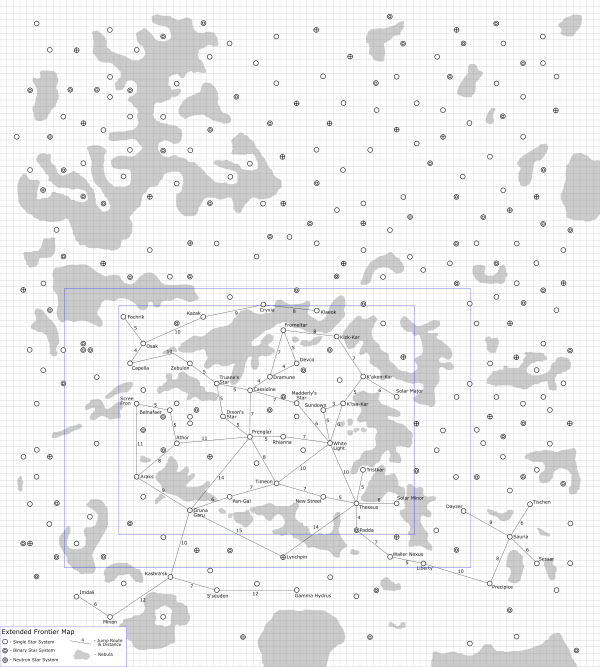
 ) that are known to the UPF, MegaCorps, pirates, or the sathar. If I was using it for my game, there are even parts of this map that I would not use (i.e. the MegaCorp planets, and S’sessu and Saurian space) at least not to begin with as those are discovered in game. I’ve set the map up with all these bits and pieces on separate layers so that I can turn them on and off as needed.
) that are known to the UPF, MegaCorps, pirates, or the sathar. If I was using it for my game, there are even parts of this map that I would not use (i.e. the MegaCorp planets, and S’sessu and Saurian space) at least not to begin with as those are discovered in game. I’ve set the map up with all these bits and pieces on separate layers so that I can turn them on and off as needed.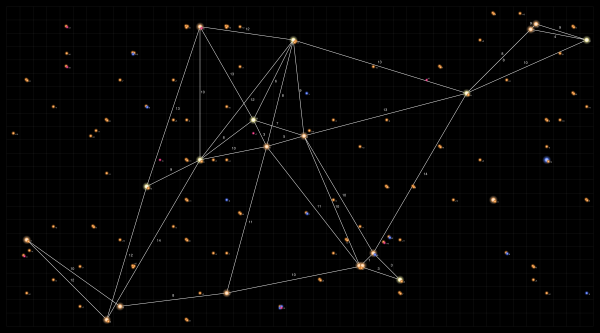


 ). But first, the map, then an outline of the Sathar attacks on the Frontier that will serve as a background for the campaigns. I should probably do a project overview post for this stuff.
). But first, the map, then an outline of the Sathar attacks on the Frontier that will serve as a background for the campaigns. I should probably do a project overview post for this stuff.
